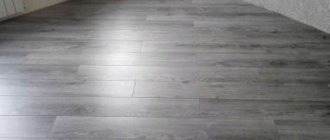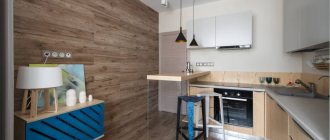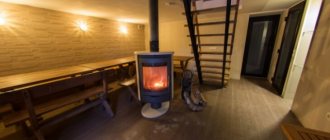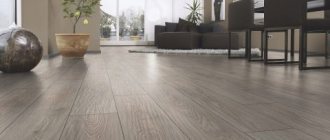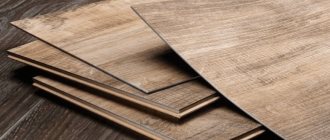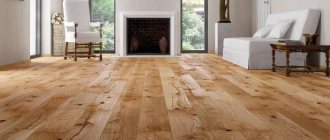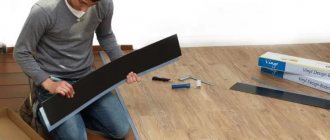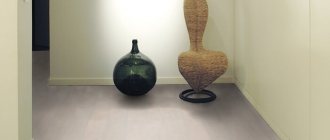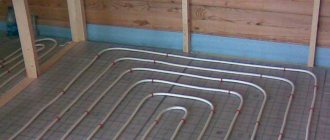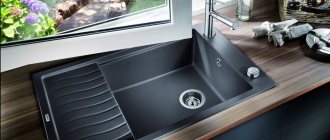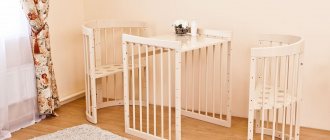New settlers and people living in the same apartment for a long time who have decided to renovate are clearly faced with the question of which flooring to choose. This is one of the most troublesome and expensive problems, when solving it it is necessary to take into account the fact that it is necessary to carry out work on laying floors that will last a long time. This wallpaper and painting are easy to change often, as soon as you are in the mood to change the design concept.
The floor is installed for many years of service, so the choice of coating is approached especially carefully, weighing all the pros and cons. They take into account the cost, service life, and methods of caring for the material. There are several types of coatings on the market: parquet, boards, laminate, linoleum and others.
Which is better: laminate or linoleum?
High-quality parquet is too expensive, and many simply cannot afford it. Boards are considered an “outdated” material with a lot of hassle - this option is practically not popular, except if an extravagant design in the “loft” style is chosen. The choice, as a rule, falls on more affordable materials: laminate and linoleum.
To make the right choice, they study the positive and negative sides of each product, and after comparing their practical advantages, make a final decision. In this article we will figure out what is better to choose – laminate or linoleum.
Both laminate and linoleum are considered fairly inexpensive materials.
Which is better: laminate or linoleum? Comparing materials
Comparative characteristics of laminate and linoleum will help you draw the right conclusions.
| № | Characteristic | Linoleum | Laminate |
| 1. | Wear resistance | It is not afraid of humidity, but is subject to external damage, is afraid of heat, and marks from furniture remain. | It has several classes of wear resistance, it does not leave marks from animal claws, sharp heels of women's shoes, or furniture, but it is deformed when exposed to moisture. |
| 2. | Installation | There are no special requirements for the floor surface, but the floor must be clean of foreign objects. Installation can be done without special training, on your own. | A flat base surface is required for installation. Correct installation should be done by an experienced professional to avoid damage to the floor, although it can be done by a less experienced person. |
| 3. | Appearance | Both materials are presented in different designs. More popular are those that imitate natural materials: any type of board, marble, granite. They are often difficult to distinguish from the real thing. | |
| 4. | Thermal insulation | A material with lower thermal and sound conductivity, especially with a fabric backing. | The product is suitable for installation on heated floors. |
| 5. | Price | High quality products, both have a comparable low cost. | |
| 6. | Care | Caring for the surface is easy - you can use any detergent. | Requires special care. Wipe the laminate only with a slightly damp cloth using special detergents. If dirt gets into the joints of the plates, they are thoroughly cleaned. Water should not get into the cracks. |
| 7. | Environmental friendliness | Linoleum contains many chemical compounds that, when released in a warm place, can negatively affect health. | Most laminate flooring is considered an environmentally friendly product that does not cause harm to humans. True, there are some species that emit substances harmful to humans when heated. |
| 8. | Flammability | Linoleum has a higher combustion class, which is indicated on the packaging as “G” and 1-1V. In this case, the chemical substances included in the composition release toxic gases during combustion, which are designated T1-T4 | Laminate does not burn, but smolders. At the same time, toxic substances are released from it, but in a smaller volume. Laminate is more fireproof. |
| 9 | Life time | Lower than laminate – 10-15 years. | Depends on the class of the selected product and the quality of installation - usually 15-30 years (with proper use). |
Each option has advantages and disadvantages, so you should choose the material taking into account your needs.
Where it is better to lay linoleum or laminate depends on the purpose of the room.
- It is better to lay linoleum in the kitchen, loggias and balconies, hallways, where there is a greater likelihood of floor abrasion and there may be high humidity.
- Laminate looks more modern, more suitable for living rooms, bedrooms, children's rooms and offices.
Comparative analysis of linoleum and laminate boards
To understand which is better, linoleum or laminate in an apartment, let’s compare the flooring and draw conclusions based on the following characteristics:
- price of 1 m2 of material;
- cost of laying 1 m2;
- complexity of the installation process;
- requirements for the floor screed surface;
- possibility of disassembly (dismantling);
- life time;
- fire safety;
- wear resistance;
- resistance to UV rays (fading);
- resistance to static loads;
- resistance to dynamic loads;
- resistance to mechanical damage;
- waterproof;
- thermal conductivity;
- soundproofing properties;
- environmental friendliness;
- ease of care;
- which gets polluted faster;
- use under a “warm floor” system;
- design.
Which is cheaper?
One of the main criteria for choosing a floor is its price. Therefore, you first need to decide what is cheaper - laminate or linoleum in the apartment. If we take budget building materials, then linoleum is about 2 times cheaper than laminate - the price of linoleum starts from 120 rubles/m2, laminate boards - from 260 rubles/m2.
In the premium class, the difference is even greater - 2.3 times: linoleum can be bought for 360-600 rubles/m2, laminate - for 840-1400 rubles/m2. Conclusion: in this comparison, linoleum has an undoubted advantage.
Which is cheaper to install?
In addition to the price of the material itself, the cost of laying the floor has a significant impact on the owner’s wallet. To install laminate directly, you can hire a team of builders for 250-400 rubles/m2, plus 150 rubles/m2 for laying waterproofing and underlayment. Linoleum flooring will cost from 90 rubles/m2.
Conclusion: laying laminate flooring is expensive, so linoleum has the advantage. However, when doing the work yourself, the materials have almost parity - to lay the lamellas you need a tool that you need to either buy or rent.
What is more difficult to lay?
Laying the flooring in both cases is quite simple - even a beginner can handle the job. However, the labor intensity of the work and its complexity still make a difference - laying laminate flooring will require good knowledge of technology, attentiveness, ability to work with tools and much more time for the entire process. Conclusion: the indicator is in favor of linoleum, although with a slight advantage.
Which material has simpler requirements for floor screed?
Linoleum and laminate require an equally flat base surface on which to lay. Any unevenness affects the surface of the material - linoleum is wiped off in such places, and the locks of the laminate are destroyed.
The effect of bumps up to 3 mm in height on the floor covering is eliminated by using a backing for the laminate, felt or PVC film for linoleum (glued to the bottom of the material). For large differences in height, it is necessary to carry out additional leveling of the screed. Conclusion: the materials are completely equal.
Which is easier to dismantle?
Linoleum can be removed in a few minutes. You will have to tinker with the laminate - very often the locks during operation are firmly glued together and are difficult to dismantle. Conclusion: removing linoleum from the floor is simpler and easier.
Which is more durable?
According to the service life declared by the manufacturers, both materials have an approximate parity of 10-15 years. However, during operation, linoleum is easier to damage: scratches from sharp objects, melted areas from an iron or ash from cigarettes, traces from moving furniture and black rubber soles.
Linoleum can break through under strong pressure, retain an impact mark for a long time, etc. The listed reasons sharply reduce its service life. Laminate is not so afraid of dynamic and static loads, it is not afraid of sharp objects - it is difficult to scratch it. Conclusion: for the first time, laminate has, at least a small, advantage - it is more practical.
Traces from heavy furniture.
Which material burns worse?
Linoleum is made from chemical components. Therefore, its ability to burn is much higher. The inscriptions on the packaging also remind us of this, where the flammability class is indicated by the letter “G” (flammability) and numbers from 1 to 4 (class). Another problem: when linoleum burns, toxic substances are released, as is reminded by the classifiers designated T1-T4 (increasingly).
Laminate does not support an open flame - it smolders. However, it also releases harmful substances, however, in small quantities. All this served as the basis for laminate manufacturers not to indicate flammability and toxicity classes for their products. Conclusion: in terms of fire safety, laminate has an undoubted leadership.
Which material has higher wear resistance?
In terms of this indicator, the materials are approximately equal - in residential premises they cannot be wiped while walking. When exposed to abrasive materials, they also quickly become unusable - traces remain that cannot be removed. Conclusion: the indicator can be ignored - none of the materials has an advantage.
Which burns out less?
There is no strict connection to a specific type of material. Everything is determined by the absence or presence of a special film (by the way, whether it is on the surface of the material or not does not affect the price) that protects the decorative layer from ultraviolet radiation. It is difficult to independently determine the presence of a protective film. Therefore, ask consultants or gym managers. Conclusion: the materials are completely equal.
Which is stronger
Here we compare the materials according to three indicators: resistance to static and dynamic loads, as well as mechanical damage. In all three characteristics, the undoubted leader is laminate. When installing furniture, it is important to prevent two or more legs from falling on one laminate board - the locks will be destroyed.
Linoleum can withstand heavy furniture, but footprints remain almost until the end of its service life. Sharp objects leave scratches that cannot be removed. When an office chair with legs is used for a long time in one place, abrasion appears on the linoleum. Conclusion: laminate is definitely stronger.
Which material has higher moisture resistance?
There is no need to go into details here: linoleum will withstand not only accidentally spilled water, but also a real flood. Laminate is hygroscopic - damp weather is enough for it to become unusable. Conclusion: if we are talking about a room with high humidity or frequent flooding, then only linoleum is needed here.
Which is warmer
Here, contrary to popular belief, linoleum is in the lead. A thin chemical material conducts heat less well than a thicker wood fiber laminate. The situation is evened out by thermal insulation of the floor under the laminate. Conclusion: linoleum retains heat better, although, as noted on the forums, it is colder in tactile sensations.
Which is quieter?
Laminate is a very good resonator. Almost everything that happens in the apartment can be heard by the neighbors below. Such a floor also disturbs the residents themselves - sounds scatter well throughout the rooms. Carrying out perfectly executed soundproofing work solves the problem by 90 percent. For example, the clicking of thin heels cannot be drowned out no matter how hard you try.
Linoleum not only absorbs all types of extraneous noise well, but also does not conduct apartment sounds to the walls and ceilings. He is the most silent floor. Conclusion: linoleum is the undisputed leader in noise absorption.
Which is more harmful?
Regarding the health hazards of the analyzed materials, the situation is a little confusing. Under optimal operating conditions, each material is environmentally friendly, so much so that a small child can play on both laminate and linoleum without any health consequences. When the temperature regime deviates from the optimal one, for example, upward, both materials begin to release harmful substances into the air. But we emphasize that this is under force majeure circumstances.
Conclusion: despite the chemical components included in the materials, they are both safe for human health.
Which is easier to wash?
It is very easy to care for both types of material. If necessary, detergents can be used. The only limitation: laminate flooring must be washed with a wrung-out cloth. Yes, black shoe marks on linoleum can be easily removed with a cotton swab soaked in acetone. Conclusion: there is complete equality here.
Which gets dirty faster?
Due to the accumulation of static electricity, the laminate becomes dirty faster. But this minus, oddly enough, has its own plus: there is less dust on the walls, shelves, lamps and various decorative elements, which is much easier to wipe from the floor than from the items listed above. Conclusion: paradoxically, experts give preference on this issue to laminate, although it gets dirty faster.
What type of material can be laid on a “warm floor”
“Warm floors”, which have become popular recently, can work in conjunction with both laminate and linoleum. Manufacturers directly indicate that they can be laid on “warm floor” systems. Conclusion: there is no advantage in this indicator for any type of sex.
What's more beautiful
The varied designs of laminate and linoleum have led to the fact that it is often visually difficult to determine the type of flooring. Different colors, textures, patterns allow you to implement the most unexpected solutions for flooring when decorating the interior of a room and apartment as a whole. Conclusion: both materials do not create problems for the designer.
It is difficult to determine the type of material by external signs.
To conclude the topic of which is better, laminate or linoleum, here is an expert’s opinion: linoleum is more of a kitchen type of floor, although it can be installed in any room of the apartment, but it is less desirable in the bedroom and children’s room due to a slightly noticeable odor. In addition, it is ideal for loggias and balconies. Laminate was conceived and produced for residential premises - it has a more presentable appearance. It is undesirable in the kitchen and unacceptable in the bathroom.
What is better for a house and an apartment?
Many people wonder which coating is more suitable for a private home and which for an apartment. In general, both laminate and linoleum are suitable for any type of housing - they both have their advantages and disadvantages, their installation is quite simple. True, as experience shows, many people prefer to use linoleum for apartments. Why? Firstly, there is almost no noise from walking on it or moving furniture, which cannot be said about laminate flooring, especially if you walk on it in shoes. This causes discomfort to both the residents of the apartment and the neighbors below.
Secondly, linoleum is not afraid of moisture - therefore, in the event of flooding, you will not have to completely change the floor covering.
Both coatings are suitable for a private home. But the choice, of course, remains with everyone.
So, each of the presented options for budget flooring, as you can see, has both pros and cons. It is quite difficult to specifically determine which is better, since everything depends on the financial capabilities of the buyer and the purpose of the purchase. When choosing, we recommend that you rely on the quality of the material, and also take into account the specific room in which you plan to place this or that floor covering. This will allow you to choose the best option.
Comparison of laminate and linoleum
Now let's compare the pros and cons of the materials to find out the winner in our dispute.
Table 1. Comparative characteristics
| Parameter | Linoleum | Laminate |
| Thermal insulation characteristics | The thermal insulation properties of the material are determined by the type of base, as well as its thickness. Options on felt, fabric and foam bases perform well. It is quite possible to walk barefoot on linoleum laid on a concrete floor | Laminate itself is a cold material, so a heat-insulating backing must be placed underneath it. This property of the laminate depends on it. Substrates come in different types and thicknesses. |
| Soundproofing | Since linoleum is a soft and quite elastic material, you can move on it completely silently. Nothing should bother the neighbors below. | Walking on laminate flooring in shoes will be heard throughout the apartment. The neighbors will also not be disturbed by anything, since there is a substrate under the material that effectively absorbs sounds. |
| Ecological cleanliness | PVC linoleum is considered absolutely neutral and does not emit toxic substances | Laminate flooring can be a source of potential danger. We are talking about cheap material that contains formaldehyde, which is harmful to our health. |
| Moisture resistance | The material cannot be damaged by water. Works great in kitchens and hallways where footwear can cause moisture | Laminate is afraid of water, with the exception of some classes. It is better to lay it only in rooms where there is no risk of getting wet. Cleaning laminate flooring is allowed only with slightly damp cloths. |
| Care | Washing linoleum is very simple; there are practically no restrictions on the use of cleaning products. The coating is moderately dirty | Laminate flooring should be removed with care. The coating has a static effect, which leads to rapid accumulation of dust on the surface. |
| Mechanical strength | It is quite easy to damage linoleum with strong pressure and exposure to sharp objects, especially types with a foam backing | The material has good strength characteristics and can survive the fall of heavy things. The front surface can be scratched. |
| Transportation | Rolled linoleum cannot be folded, so transportation requires a vehicle with the appropriate body parameters. | Laminate is supplied in bundles that are easy to stack. |
| Appearance | Despite modern technologies and the ability to imitate coatings, linoleum does not give the impression of an expensive material. If you evaluate its appearance on a 10-point scale, you can give it a solid 6. | Here everything is much more interesting, since the material is thick enough to create textured surfaces. This gives the coating more naturalness and beauty. |
Comparison of materials laying methods
The last point by which we compare the heroes of the review will be editing. Here are two quick instructions.
Both types of coating require a well-prepared base and acclimatization in the room, so we will not indicate these points in comparison.
Table 2. Laying linoleum
| Steps, photo | Description |
Step 1 – spread the material | Linoleum is carried into the room and rolled out across the floor. The advantage is that we cover the entire room at once. Minus - there should be nothing unnecessary in the room. Advice! The task becomes more complicated when the piece of linoleum is clearly larger than the room - you have to tinker. |
Step 2 - Trimming | Next, the material is cut to fit the room in such a way that there is a 5-7 mm technological gap left to the walls. This is done very quickly using a stationery or special knife. Then the linoleum is laid out and the baseboards are installed. |
Everything is extremely simple and fast. In some situations, installation is performed using glue or double-sided tape.
Table 3. Laying laminate
| Steps, photo | Description |
Step 1 - laying the substrate | At the first stage, the floor in the room is covered with a substrate. It can be rolled or sheet. The joints of the material are taped. |
Step 2 - assembling the cover | Then the coating is assembled. A technological gap is also left to the walls, which is subsequently covered with a plinth. Assembly is carried out either piece by piece or in sequence. The second option is simpler, but one pair of hands may not be enough to perform it. The whole procedure takes much longer than laying linoleum |
Step 3 - cutting the laminate | The finishing panel of each row is trimmed according to the fact. An electric jigsaw is used for this. When cutting, a lot of dust gets into the air, so it is recommended to wear a respirator. The next row starts with the remaining piece of laminate. In this case, it is necessary to ensure that in the rows there is an offset of the transverse seams in increments of at least 20 cm relative to each other. The laminate is also cut at the junction with the pipes - again, linoleum is easier to fit in such a situation. |
It is worth mentioning separately about the laying of the last row - it is trimmed along its entire length, after which it is neatly joined to the already assembled canvas. If you lack experience, it may not be possible to perform this procedure efficiently - it requires tools and skill.
Do you want to know what tools will help you lay laminate flooring quickly and with minimal effort? Read the article “Tools for laying laminate flooring.”
So, in our opinion, the fight is approximately equal. Each of the participants takes the lead according to one criterion or another. The type and class of material is of great importance, so it is very difficult to make an unambiguous verdict.
Prices for Tarkett linoleum
linoleum tarkett
